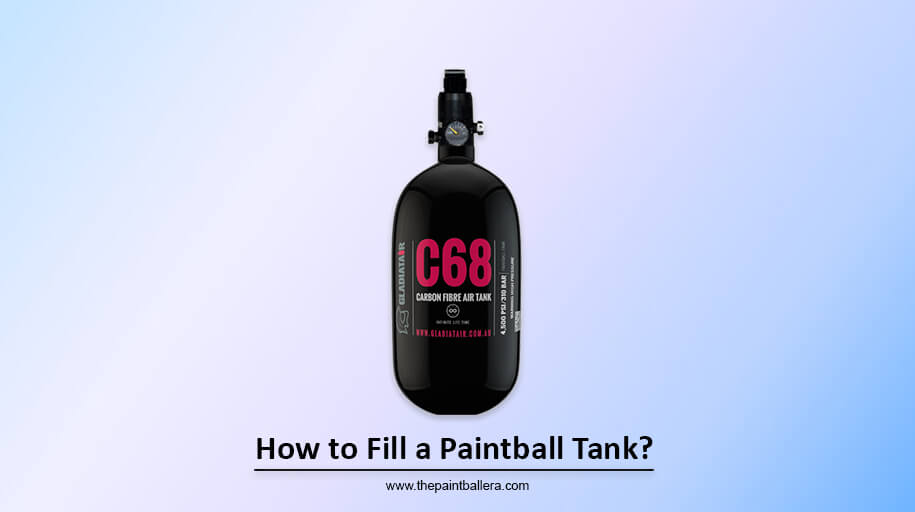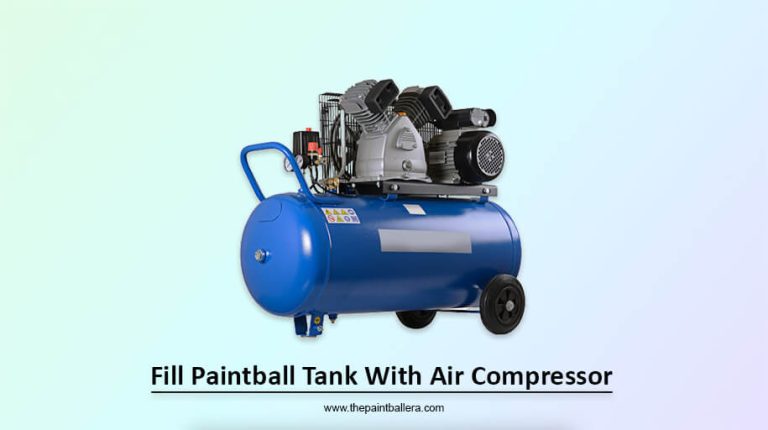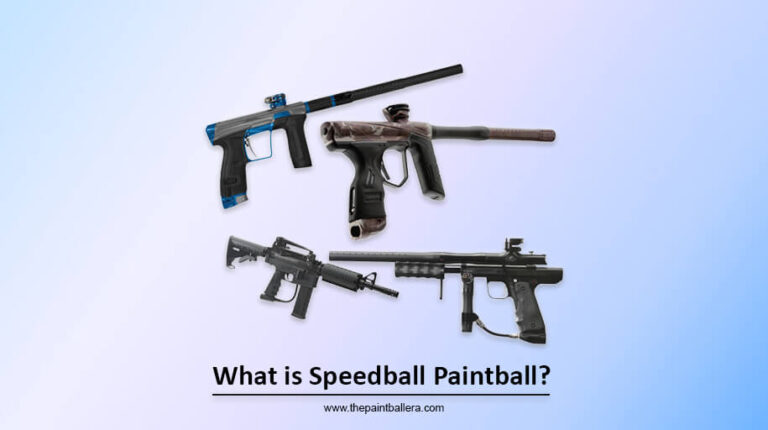How to Fill a Paintball Tank?

Hey there, paintball enthusiasts! If you’re reading this, chances are you’re passionate about paintball, just like me. But we all know running out of gas during an epic battle is a major buzzkill. That’s why it’s crucial to understand how to fill a paintball tank so you can keep the action going without any hitches.
Today, I will walk you through everything you need to know about refilling your paintball tank from the different types of tanks to a step-by-step guide on doing it yourself at home.
Types of Paintball Tanks
When it comes to paintball, the type of tank you use can significantly influence your performance on the field. Generally, paintball tanks fall into three categories:
Co2 Tanks
Co2 tanks are the old-school favourites. They’re cost-effective and easy to find, making them an excellent option for beginners. However, they’re sensitive to temperature changes, affecting their performance.
Compressed Air Tanks
These tanks are filled with high-pressure air and are a more stable option for consistent shooting. Many serious players prefer them, but they can be a bit pricey.
Nitrogen Tanks
Nitrogen tanks are less standard but work similarly to compressed air tanks. They offer excellent consistency and can perform well in various environmental conditions. However, they can be expensive and are less widely available.
How To Refill CO2 Paintball Tank With Air Compressor
Before we get into the nitty-gritty of refilling your Co2 tank, it’s important to note that these tanks require special care. Oil from the air compressor can seep into the tank and affect your paintball gun’s performance.
Parts Of Paint gun Ball Affected By Oil
The oil from the compressor can harm various parts of your paintball gun, such as the o-rings, seals, and barrel. Even a tiny amount of oil can compromise the gun’s performance, leading to less accurate shots or internal damage.
Compressed Air Tanks
Compressed air tanks are a favourite among many seasoned paintball players. Unlike Co2 tanks, they offer a more consistent pressure output, making your shots more accurate and reliable.
The tank comprises an aluminum or carbon fiber body containing compressed air up to a specific PSI (Pounds per Square Inch). They’re more of an investment initially, but worth it for the performance boost you get on the field.
Check Your Last Hydrostatic Test Date
Before you go ahead and start the refill process, whether it’s a CO2 or compressed air tank, it’s essential to check your tank’s last hydrostatic test date. This date is usually stamped onto the tank itself.
Hydrostatic testing ensures the tank’s structural integrity and ability to hold compressed gases safely. Generally, tanks need to be tested every 3-5 years.
If your tank is overdue for a test, it’s a no-go for refilling. Better safe than sorry, right? Ignoring this could result in a compromised tank, and I can’t stress enough how dangerous that could be.
There you have it, folks! We’ve covered the basics of compressed air tanks and the importance of checking the hydrostatic test date. I’ve been in situations where I overlooked these details, and let me tell you, it’s not something you want to learn the hard way.
Next, we’ll delve into the steps you need to take to refill your paintball tank with an air compressor at home.
Ventilation
First things first—ventilation is critical. You’ll be dealing with compressed gases, and the last thing you want is for these to accumulate in an enclosed space. So, ensure you’re in a well-ventilated area, like a garage with the door open or, even better, outside.
Trust me, a little fresh air goes a long way in making this process safer and more comfortable. I can’t tell you how many times I’ve seen folks disregard this, and it’s honestly a risk that’s not worth taking.
Release Remaining Air From The Tank
Before connecting your tank to the air compressor, releasing any remaining air is critical. This might seem counterproductive—why let out what little you have left? But this step ensures you start the refilling process from zero, enabling a more accurate and complete fill. Plus, residual air can sometimes mess with the refilling process, so it’s better to empty it.
To release the air, safely point the tank’s nozzle away from you or anyone else and slowly open the valve. You’ll hear a hissing sound as the air escapes. Make sure the tank is empty before you proceed.
And there you have it! Ventilation and releasing remaining air might seem minor, but they’re pivotal for a smooth and safe refilling. I learned these tips from seasoned players, and trust me, you want to take advantage of them.
Next, we’ll cover how to connect your paintball tank to the air compressor and start the refilling process.
Connect the Paintball Tank And Air Compressor
Before connecting anything, ensure that your tank and the air compressor are switched off. Locate the tank’s nozzle and the air compressor’s hose—these are what you’ll be connecting. Your paintball tank usually has a threaded nozzle that fits snugly onto the compressor hose.
Attach the two securely, making sure there’s no room for air to escape. If they’re not working well, double-check to ensure you use the correct attachments or adaptors. This is a moment where you don’t want to rush; take your time to get it right.
How To Open The Valve To Refill The Tank
After securely connecting the tank and compressor, you can open the valve and start the refill. Please turn on the air compressor first, letting it build up pressure (but not releasing air yet).
Then, carefully open the valve on the paintball tank. You’ll hear a gushing sound as the tank fills with compressed air or CO2. Keep a close eye on the pressure gauge to ensure you’re filling appropriately, and always prioritize safety over speed.
And there we have it—connecting your tank and opening the valve are crucial steps that set the stage for a successful refill. I’ve been through this process more times than I can count, and each time, it reminds me how important these little details are. Next, we’ll go through a step-by-step guide to refilling your paintball tank at home.
Step By Step To Refilling Your Paintball Tank At Home
Refilling your paintball tank at home can seem daunting, but it becomes a walk in the park with the proper steps. Here’s a comprehensive guide:
Check Your Tank’s PSI Indicator
Before you start, look at your tank’s PSI (Pounds per Square Inch) indicator to know the maximum pressure it can handle. It’s super crucial to stay within this limit for safety reasons.
Release The Air
We touched on this earlier, but it’s worth repeating. Make sure to release any remaining air from the tank before refilling it. This ensures you get a complete and accurate fill.
Ensure The Nozzles Are Well-Connected
Double-check that the nozzle of the paintball tank and the air compressor hose are tightly connected. Any air leak could be both wasteful and potentially dangerous.
Examine The State Of The Compressor
Before you turn anything on, give your air compressor a once-over. Make sure it’s in good condition and ready to perform.
Do A Counter Check
Take one last look to ensure everything is set up correctly. I always do this as a final precaution.
Check For The ‘Hot Fill’
Sometimes, the tank gets warm during the filling process. If that happens, pause and let it cool down before resuming.
Detach The Hose
Once you’re sure your tank has been appropriately filled and slowly released the air to equalize the pressure, it’s time for the last but crucial step—detaching the hose.
Turn off your air compressor and carefully unscrew the hose from the paintball tank’s nozzle. Do this gently to avoid any residual pressure from escaping suddenly, which could be hazardous.
Conclusion
And there you have it—the comprehensive guide on how to fill a paintball tank. We’ve covered everything from choosing the right type of tank and preparing your equipment to the actual step-by-step refilling process.
I hope this guide empowers you to take charge of your paintball experience, making it more enjoyable and hassle-free. With a bit of practice and attention to detail, you’ll refill your tank like a pro in no time, ensuring you never run out of gas when you most need it.
Frequently Asked Questions
Before we wrap things up, let’s tackle some common questions I often hear from new and experienced paintball players.






